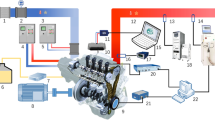Abstract
Turbocharging and direct injection are main technologies used for energy-saving gasoline engines. But the biggest challenge is super-knock, whose mechanism is unclear and has no effective strategy to suppress this super-knock until now. The effects of injection strategies on super-knock were experimentally investigated in a turbocharged GDI engine. It was found that two-stage injections during intake stroke (TSII) can eliminate super-knock. Meanwhile, the fuel consumption, emissions and exhaust temperature can keep optimized level. By sweeping the start of the 1st injection (SOI1), end of the 2nd injection (EOI2) and the split injection ratios (ROI2) using 5000 cycles evaluation test at low-speed high load operating point, the optimized injection strategy for the typical TC-GDI engine is TSII with SOI1 at middle of intake stroke, EOI2 at end of intake stroke, and ROI2 of 0.3.
Similar content being viewed by others
References
U.S. EPA (Environmental Protection Agency). Inventory of U.S. greenhouse gas emissions and sinks: 1990–2009. Report No. EPA 430-R-11-005, U.S. EPA, Washington, D.C., 2011
U.S. EPA (Environmental Protection Agency). Light-duty automotive technology, carbon dioxide emissions and fuel economy trends: 1975 through 2010. Report No. EPA 420-R-10-023, U.S. EPA, Washington, D.C., 2010
Willand J, Marc D, Geringer B, et al. Limits on downsizing in spark ignition engines due to pre-ignition. MTZ, 2009, 70: 56–61
Winklhofer E, Hirsch A, Kapus P. TC GDI engines at very high power density-irregular combustion and thermal risk. SAE Paper 2009-24-0056, 2009
Zaccardi J, Duval L, Pagot A. Development of specific tools for analysis and quantification of pre-ignition in a boosted SI engine. SAE 2009-01-1795, 2009
Amann M, Alger T, Westmoreland B. The Effect of EGR on low-speed pre-ignition in boosted SI engines. SAE 2011-01-0339, 2011
Zhang Z, Shu G, Liang X, et al. Super knock and preliminary investigation of its influences turbocharged GDI engine. Trans CSICE, 2011, 29(5): 422–426
Norbert P, Bruno K. Super-knock prediction using a refined theory of turbulence. SAE 2013-01-1109, 2013
Inoue T, Inoue Y, Ishikawa M. Abnormal combustion in a highly boosted SI engine-The occurrence of Super Knock. SAE 2012-01-1141, 2012
Zahdeh A, Rothenberger P, Nguyen W. Fundamental approach to investigate pre-ignition in boosted SI engines. SAE 2011-01-0340, 2011
Dahnz C, Han K, Spicher U. Investigations on pre-ignition in highly supercharged SI engines. SAE 2010-01-0355, 2010
Author information
Authors and Affiliations
Corresponding author
Rights and permissions
About this article
Cite this article
Wang, Z., Xu, Y. & Wang, J. Suppression of super-knock in TC-GDI engine using two-stage injection in intake stroke (TSII). Sci. China Technol. Sci. 57, 80–85 (2014). https://doi.org/10.1007/s11431-013-5374-3
Received:
Accepted:
Published:
Issue Date:
DOI: https://doi.org/10.1007/s11431-013-5374-3




